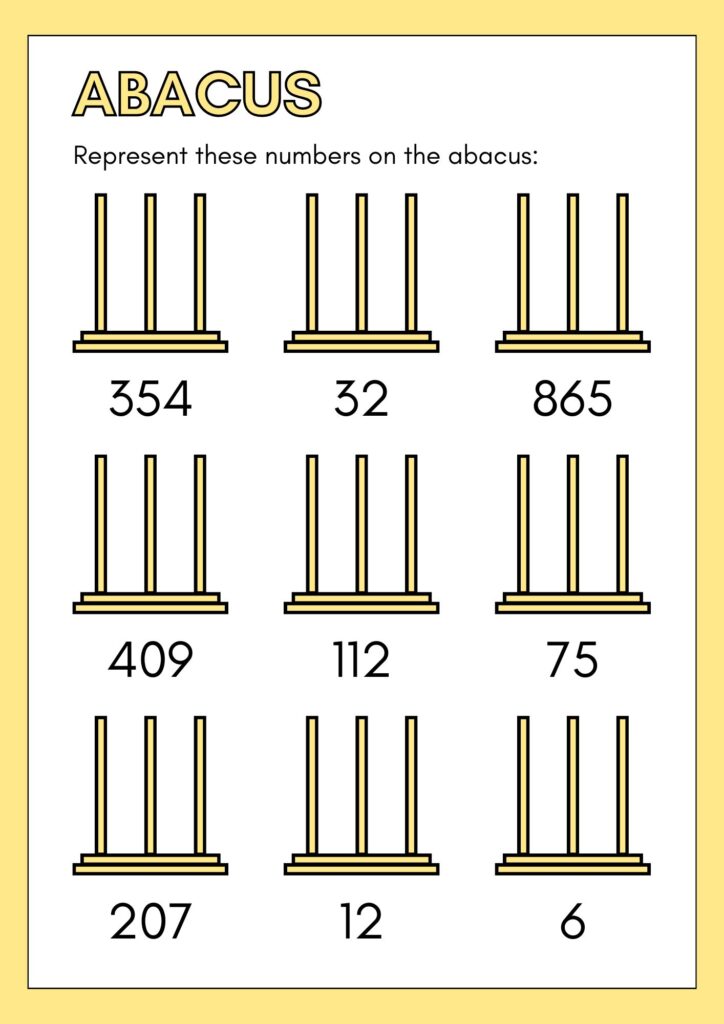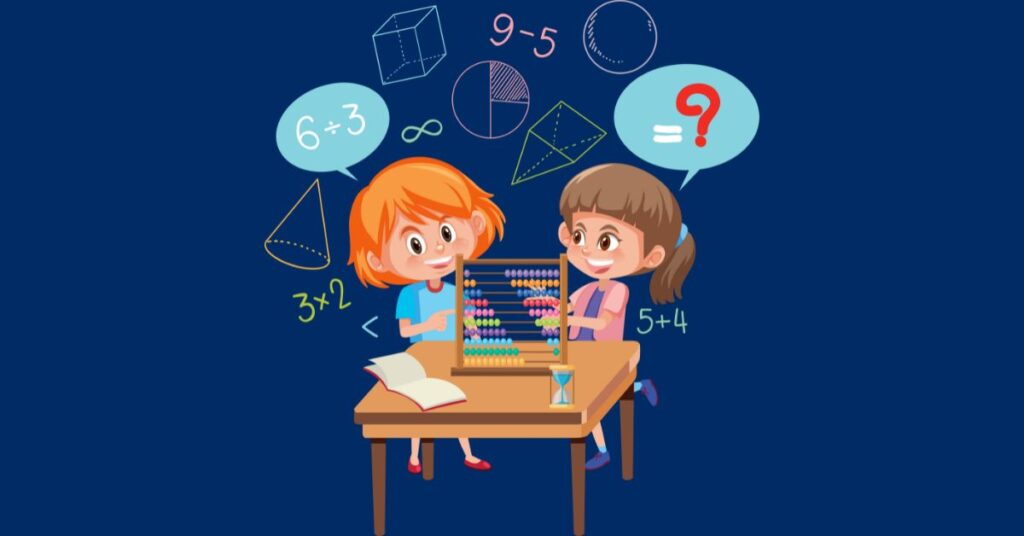Abacus is a fun way to teach math to children. In this article, we will discuss the abacus
maths learning procedure, and its benefits for kids.
Children must grow in every area to ensure a successful future for themselves in this digital world. Formal education alone cannot assist young students in developing logical reasoning, critical thinking, and problem-solving skills.
However, learning an Abacus through physical or online classes can assist them in developing several useful skills. In this article, we will provide you with a complete guide on Abacus learning and determine whether it’s suitable for kids of various ages.
Abacus Definition
An Abacus can be defined as an instrument that counts and computes by moving tiny balls or beads along rods or into grooves.
Kids and people with visual impairment can also benefit from this instrument for learning maths in a simple way. After mastering the fundamentals of abacus counting, you can quickly perform division, multiplication, subtraction, and addition.
What is Abacus Math?
People in tropical cultures used their fingers and even their toes to count before the Hindu-Arabic number system was created in India in the sixth or seventh century.
Then, as it counted even greater numbers, people added up amounts by picking up small, portable items like twigs, seashells, and pebbles. The abacus is just one of the many counting instruments developed in ancient times to assist in the computation of large numbers.
The ability to solve a mathematical equation quickly and correctly without the help of any tools, such as a calculator or computer, is known as Abacus math.
The Abacus Training helps you improve your ability, the beads on the abacus tool. In Abacus math students have to use their photographic memories to recall the last bead position and mentally complete the calculations.
How to Learn Abacus?
There are various ways to learn Abacus if you want to teach it to your kids. When you enroll your children in the best Abacus schools, skilled teachers will teach students fundamental ideas.
However, you can also signup for any online Abacus training courses of your choice. The simplest ways to learn the abacus are:
1. Match my Mood
In this method, we keep The beads in a starting line making sure that each row of beads is on the same side. After giving a demo, the teacher will ask the students to move some beads from the top row to the opposite side.
The instructor repeats the same procedure with the next bead until the kids understand the sequence. Children will surely find it easier to follow along if the teaching professional counts out the number of beads.
2. Counting Game
In this method, the instructor divides the first row of beads by moving a specific number
of beads to one side and some beads to the other side.
The students are then instructed to count the beads that have been moved to one side so they can understand how many beads are left. Through these methods, Your kids will learn the foundations of adding, subtracting, multiplying, and dividing with an abacus instrument.

How to Use Abacus?
An Abacus tool can perform various mathematical functions in the following ways:
1. Addition
Enter your starting point. Let’s say you need to include 1234 and 5678. Push up four beads in the place of the one to enter 1234 on the abacus. 1 in the thousands place, 2 in the hundreds place, and 3 in the tens place of beads.
Step 1: Start from left – The first two numbers you will combine are the one and the five from the thousands place. Here, you will move the lower bead up to represent the number six and move the single bead from the top row of that column down to represent the addition of the five.
Step 2: As adding two figures in the tens place results in 10, so you have to carry a 1 to the hundred places, to get 9 in that column. You can place your all beads in the tens line to get a zero.
Step 3: The remaining numbers are 6912 i.e. a 2 in the one’s column, a 1 in the tens column, a 9 in the hundreds, and a 6 in the thousands column. The sum of 1,234 and 5,678 equals 6,912.
2. Subtraction
Here, the procedure is reversed. Instead of carrying the numbers over from the previous column, use them. If you want to subtract 867 from 932, enter 932 into the abacus and begin subtracting from the leftmost column.
We obtained one by subtracting eight from nine, leaving one bead in the hundreds place. As you cannot subtract 6 from 3, borrow the 1 in the hundreds place and subtract 6 from 13 to get 7.
Repeat the process in range 1, borrow a bead from the tens place to make it six, so that you can subtract seven from twelve instead of two. As a result, you will get 5 in one column. Hence, you will get the right result i.e. 932 – 867 = 65.
3. Counting
We should place one or two beads in each row of the top row’s columns, while it should place four beads in each row of the bottom row’s columns.
Step 1: When you proceed, all the beads should be up in the top row and down in the bottom row, respectively. The beads in the top row each represent the value of five, while the beads in the bottom row each represent the value of one.
Step 2: Each column of beads represents a “place” value from which you can create a numeral. The “ones” place (1-9) would be in the farthest column on the right, followed by the “tens” place (10-99), the “hundreds” (100-999), and so on.
Step 3: Push one bead to the “up” position to count a digit. One would be represented by moving a single bead to the “up” position from the bottom row, and two by moving two beads.
Step 4: Since there are only four beads in the bottom row, you must move all four beads from the bottom row into the “down” position to change the number from “four” to “five.” The abacus correctly reads “five.” You can push one bead from the bottom row up to represent the number “six,”.
4. Multiply
Start at the abacus’s farthest left column. If you want to multiply 34 by 12. Columns “3”, “4”, “X”, “1”, “2,” and “=” should be assigned.
Keep the remaining right-hand columns blank to accommodate your result. Columns that are blank will stand in for the symbols “X” and “=”.
An abacus should contain a blank column, a column with one bead up, a column with two beads up in the next, a column with three beads up in the farthest column to the left, and a final blank column.
The first column needs to be multiplied by the first column after the break, then by the second column after the break.
The second column before the break will then be multiplied by the first column after the break, and finally, the second column before the break will be multiplied by the second column after the break.
Maintain the same strategy when multiplying larger numbers: start with the left-side digits and work your way to the right.
For a column that is left empty for the “=” sign, start writing in the first answer column after that. As you multiply the individual digits, keep moving the beads on the abacus’ right side.
- Multiply 3 by 1 and then write the result in the first answer column. While raising three beads in the seventh column.
- Then, Multiply the 3 by the 2 and enter the result in the eighth column. We should push one bead down from the top portion and one up from the lower section.
- Multiply 4 by 1 and move the answer (4) to the eighth column, which is the second of the answer columns. Carry one bead over to the first answer column because you are adding a 4 to a 6 in that column.
- This creates a 4 in the seventh column (four beads from the bottom section pushed up to the center bar) and a 0 in the eighth column.
- In the final column of the answer sheet, write the result of the last two digits, 4, and 2, as (8). Now that they have read 4, blank, and 8, your response should be 408.
5. Division
In Abacus Division, place the divisor in the first column from the left and Place the dividend in the columns to the right side next to the blank columns. You should also leave the remaining columns empty for the result.
If you want to divide 34 by 2, place 2 in the first column from the left, leaving two columns empty, and then move 34 to the right.
Place the result into the answer section’s first empty column by dividing the dividend’s first number (3 by the divisor’s second). Now, enter the second digit of the quotient in the next empty column of the answer section by subtracting the result from the dividend.
Your Abacus should now display the following information: The number 2 next to blank columns, 1, and 7 in your divisor, and the quotient, 17.

Benefits of Abacus
Your child will gain the following benefits from learning the abacus:
- Brain development.
- Enhanced creativity.
- Increased self-confidence.
- Improvement of IQ.
- Improved imaginative and visual abilities.
- Enhances concentration.
- Provides a good mix of speed and accuracy.
- Increased memory power.
- Makes easier to do calculations.
- Enhancement in observation skills.
Final Words
Abacus is an amazing instrument used to perform mathematical calculations since ancient
times. People used to do basic maths with the help of the Abacus when there were no tools
for calculations like calculators or computers.
Abacus is still useful as we can improve our memory and critical thinking by practicing maths on this tool. It is extremely useful for kids as they can enhance their creativity and become more skillful by learning to do maths on Abacus.
FAQs
Is Abacus good for child?
Yes, Abacus helps in brain development for children. Children who struggle to follow the
math methods taught in school can benefit a lot from Abacus learning.
Can adults learn abacus?
People of any age can learn Abacus with the right mentor and regular practice.
Does Abacus help in learning maths?
They have proven it to be one of the most effective ways for young students to do mental
math.
Abacus learning not only aids in basic calculations such as addition, multiplication,
subtraction, and division, but it also assists in the accurate counting of negative numbers,
decimal points, and so on.
Read More List Of 35+ Advantages And Disadvantages Of Video Games 40+ Advantages And Disadvantages Of Teaching
Naasongs is a comprehensive music collection offering a diverse range of tracks across various genres, catering to both regional and international audiences. The platform’s rich history and consistent technological advancements ensure a seamless user experience with high-quality audio streaming options. Featuring an intuitive user interface and effective search functionality, Naasongs provides users with quick access to their favorite music. The platform’s wide selection of musical styles and genres, coupled with positive feedback from users and critics, reflects its commitment to user satisfaction and quality. Additionally, Naa Songs‘ future expansion plans and ongoing advancements signify its continuous efforts to evolve and enhance its offering, making it the ultimate destination for music enthusiasts worldwide.

